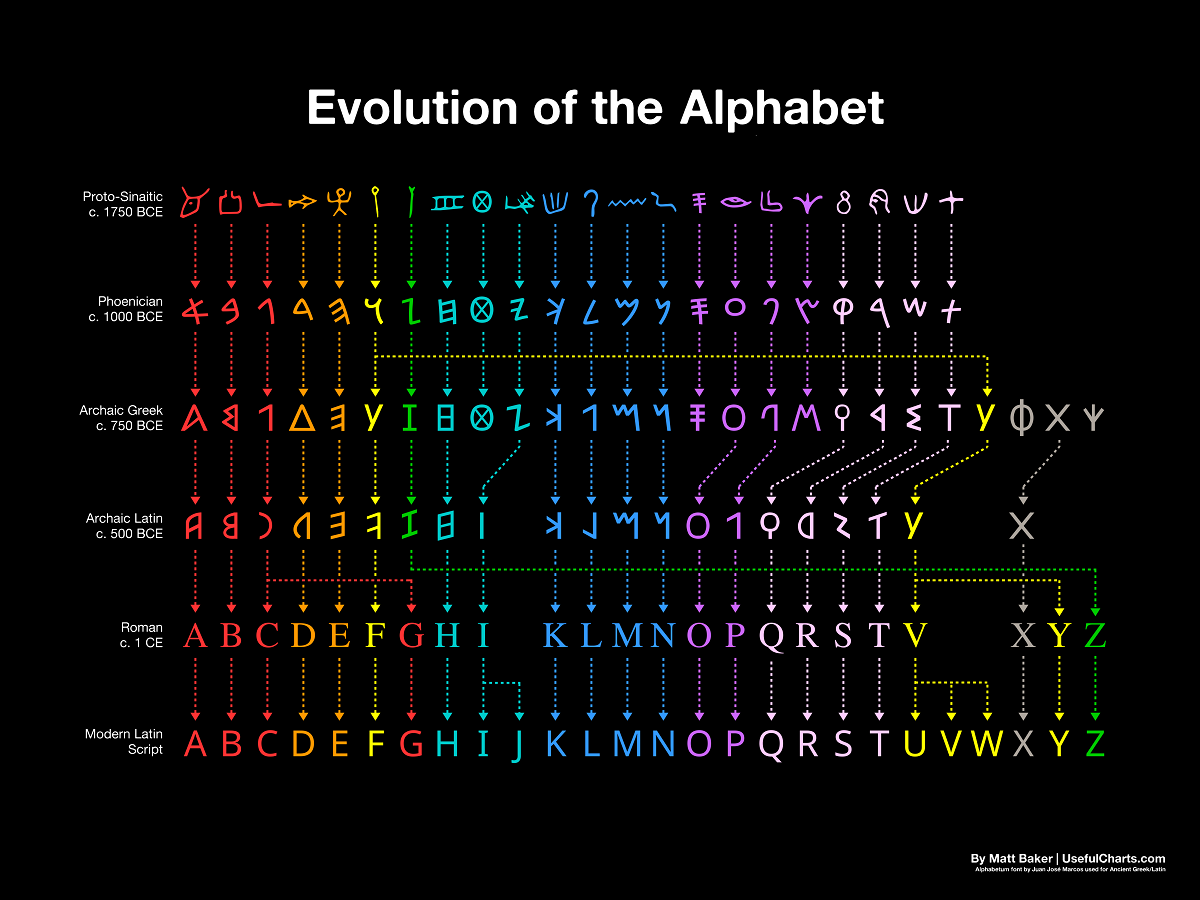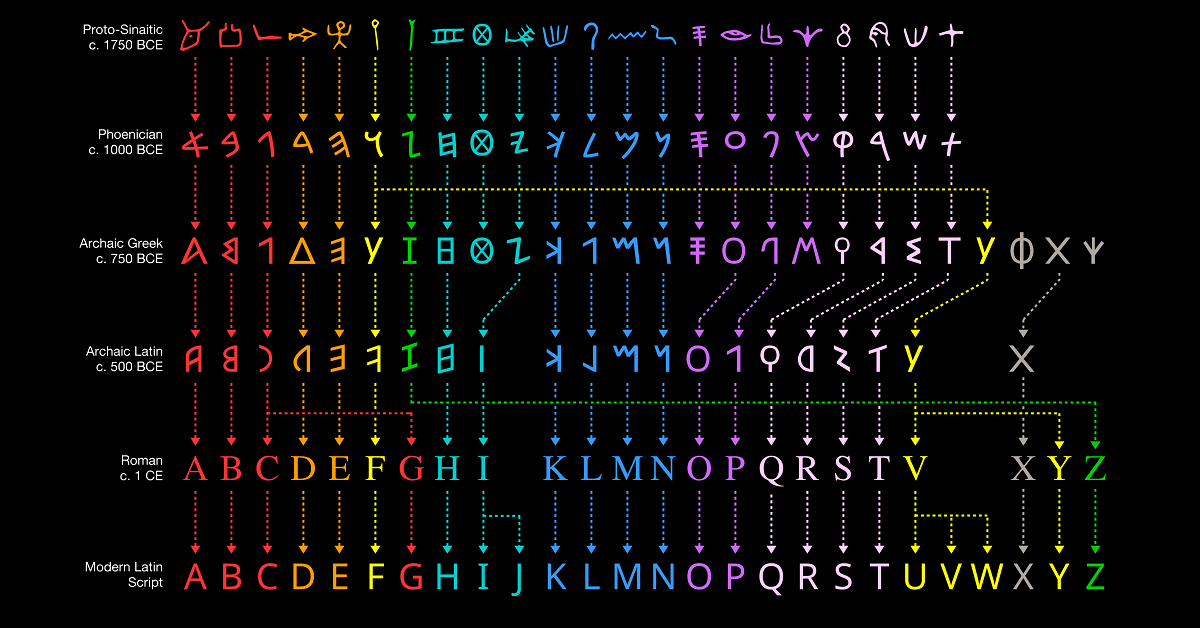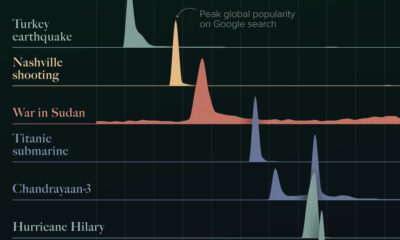Misc
From Greek to Latin: Visualizing the Evolution of the Alphabet

From Greek to Latin: Visualizing the Evolution of the Alphabet
Over the course of 2021, the Greek alphabet was a major part of the news cycle.
COVID-19 variants, which are labeled with Greek letters when becoming a variant of concern, normalized their usage. From the Alpha variant in the UK, to the Delta variant that spread from India to become the dominant global strain, the Greek alphabet was everywhere. Seemingly overnight, the Omicron variant discovered in South Africa has now taken the mantle as the most discussed variant.
But the Greek alphabet is used in other parts of our lives as well. For example, Greek letters are commonly used in mathematics and science, like Sigma (Σ) denoting a sum or Lambda (λ) used to represent the half-life of radioactive material.
And the study of linguistics shows us why using Greek letters in English isn’t completely farfetched. This visualization from Matt Baker at UsefulCharts.com demonstrates how the modern Latin script used in English evolved from Greek, and other, alphabets.
It’s All Proto-Sinaitic to Me
Before there was English, or Latin, or even Greek, there was Proto-Sinaitic.
Considered the first alphabet ever used, the Proto-Sinaitic script was derived in Canaan, around the biblical Land of Israel. It was repurposed from Egyptian hieroglyphs that were commonly seen in the area (its name comes from Mount Sinai), and used to describe sounds instead of meanings.
| Proto-Sinaitic Letter (Reconstructed Name) | Original Meaning |
|---|---|
| ʾalp | ox |
| bayt | house |
| gaml | throwstick |
| dag | fish |
| haw/hillul | praise |
| waw/uph | fowl |
| zayn/zayt | oxhide ingot/sword |
| ḏiqq | manacle |
| ḥaṣr | courtyard |
| ḫayt | thread |
| ṭab | good |
| yad | hand |
| kap | palm |
| lamd | goad |
| maym | water |
| naḥaš | snake |
| ṡamk | peg |
| ʿayn | eye |
| ġabi | calyx |
| pʿit | corner |
| ṣaday | plant |
| qoba | needle/nape/monkey |
| raʾš | head |
| šimš | sun |
| śadeh | field |
| ṯann | bow |
| tāw | mark |
As the first Semitic script, Proto-Sinaitic soon influenced other Semitic languages. It was the precursor to the Phoenician alphabet, which was used in the area of modern-day Lebanon and spread across the Mediterranean and became the basis for Arabic, Cyrillic, Hebrew, and of course, Greek.
Evolving into the Greek, Roman, and Latin Alphabets
Over time, the alphabet continued to become adopted and evolve across different languages.
The first forms of the Archaic Greek script are dated circa 750 BCE. Many of the letters remained in Modern Greek, including Alpha, Beta, Delta, and even Omicron, despite first appearing more than 2,500 years ago.
Soon the Greek alphabet (and much of its culture) was borrowed into Latin, with Archaic Latin script appearing circa 500 BCE. The evolution into Roman script, with the same recognizable letters used in modern English, occurred 500 years later in 1 CE.
| Alphabet | Usage (Year) |
|---|---|
| Proto-Sinaitic | ~ 1,750 BCE |
| Phoenician | ~ 1,000 BCE |
| Archaic Greek | ~ 750 BCE |
| Archaic Latin | ~ 500 BCE |
| Roman | ~ 1 CE |
| Modern Latin | Today |
Many of the letters which first came from Egyptian hieroglyphs made their way into modern English, but they took a long and convoluted journey. As the graphic above highlights, some letters evolved into multiple forms, while others fell out of use entirely.
And this is just a snapshot of the many scripts and languages that the modern English alphabet evolved from. Lowercase letters came from Roman cursive, which evolved into the Insular and Carolingian scripts before becoming modern lowercase English.
Like many things in the long arc of human culture, alphabets are not as far removed from each other as you might think.
Maps
The Largest Earthquakes in the New York Area (1970-2024)
The earthquake that shook buildings across New York in April 2024 was the third-largest quake in the Northeast U.S. over the past 50 years.

The Largest Earthquakes in the New York Area
This was originally posted on our Voronoi app. Download the app for free on Apple or Android and discover incredible data-driven charts from a variety of trusted sources.
The 4.8 magnitude earthquake that shook buildings across New York on Friday, April 5th, 2024 was the third-largest quake in the U.S. Northeast area over the past 50 years.
In this map, we illustrate earthquakes with a magnitude of 4.0 or greater recorded in the Northeastern U.S. since 1970, according to the United States Geological Survey (USGS).
Shallow Quakes and Older Buildings
The earthquake that struck the U.S. Northeast in April 2024 was felt by millions of people from Washington, D.C., to north of Boston. It even caused a full ground stop at Newark Airport.
The quake, occurring just 5 km beneath the Earth’s surface, was considered shallow, which is what contributed to more intense shaking at the surface.
According to the USGS, rocks in the eastern U.S. are significantly older, denser, and harder than those on the western side, compressed by time. This makes them more efficient conduits for seismic energy. Additionally, buildings in the Northeast tend to be older and may not adhere to the latest earthquake codes.
Despite disrupting work and school life, the earthquake was considered minor, according to the Michigan Technological University magnitude scale:
| Magnitude | Earthquake Effects | Estimated Number Each Year |
|---|---|---|
| 2.5 or less | Usually not felt, but can be recorded by seismograph. | Millions |
| 2.5 to 5.4 | Often felt, but only causes minor damage. | 500,000 |
| 5.5 to 6.0 | Slight damage to buildings and other structures. | 350 |
| 6.1 to 6.9 | May cause a lot of damage in very populated areas. | 100 |
| 7.0 to 7.9 | Major earthquake. Serious damage. | 10-15 |
| 8.0 or greater | Great earthquake. Can totally destroy communities near the epicenter. | One every year or two |
The largest earthquake felt in the area over the past 50 years was a 5.3 magnitude quake that occurred in Au Sable Forks, New York, in 2002. It damaged houses and cracked roads in a remote corner of the Adirondack Mountains, but caused no injuries.
| Date | Magnitude | Location | State |
|---|---|---|---|
| April 20, 2002 | 5.3 | Au Sable Forks | New York |
| October 7, 1983 | 5.1 | Newcomb | New York |
| April 5, 2024 | 4.8 | Whitehouse Station | New Jersey |
| October 16, 2012 | 4.7 | Hollis Center | Maine |
| January 16, 1994 | 4.6 | Sinking Spring | Pennsylvania |
| January 19, 1982 | 4.5 | Sanbornton | New Hampshire |
| September 25, 1998 | 4.5 | Adamsville | Pennsylvania |
| June 9, 1975 | 4.2 | Altona | New York |
| May 29, 1983 | 4.2 | Peru | Maine |
| April 23, 1984 | 4.2 | Conestoga | Pennsylvania |
| January 16, 1994 | 4.2 | Sinking Spring | Pennsylvania |
| November 3, 1975 | 4 | Long Lake | New York |
| June 17, 1991 | 4 | Worcester | New York |
The largest earthquake in U.S. history, however, was the 1964 Good Friday quake in Alaska, measuring 9.2 magnitude and killing 131 people.
-

 Business2 weeks ago
Business2 weeks agoAmerica’s Top Companies by Revenue (1994 vs. 2023)
-

 Environment1 week ago
Environment1 week agoRanked: Top Countries by Total Forest Loss Since 2001
-

 Markets1 week ago
Markets1 week agoVisualizing America’s Shortage of Affordable Homes
-

 Maps2 weeks ago
Maps2 weeks agoMapped: Average Wages Across Europe
-

 Mining2 weeks ago
Mining2 weeks agoCharted: The Value Gap Between the Gold Price and Gold Miners
-

 Demographics2 weeks ago
Demographics2 weeks agoVisualizing the Size of the Global Senior Population
-

 Misc2 weeks ago
Misc2 weeks agoTesla Is Once Again the World’s Best-Selling EV Company
-

 Technology2 weeks ago
Technology2 weeks agoRanked: The Most Popular Smartphone Brands in the U.S.















